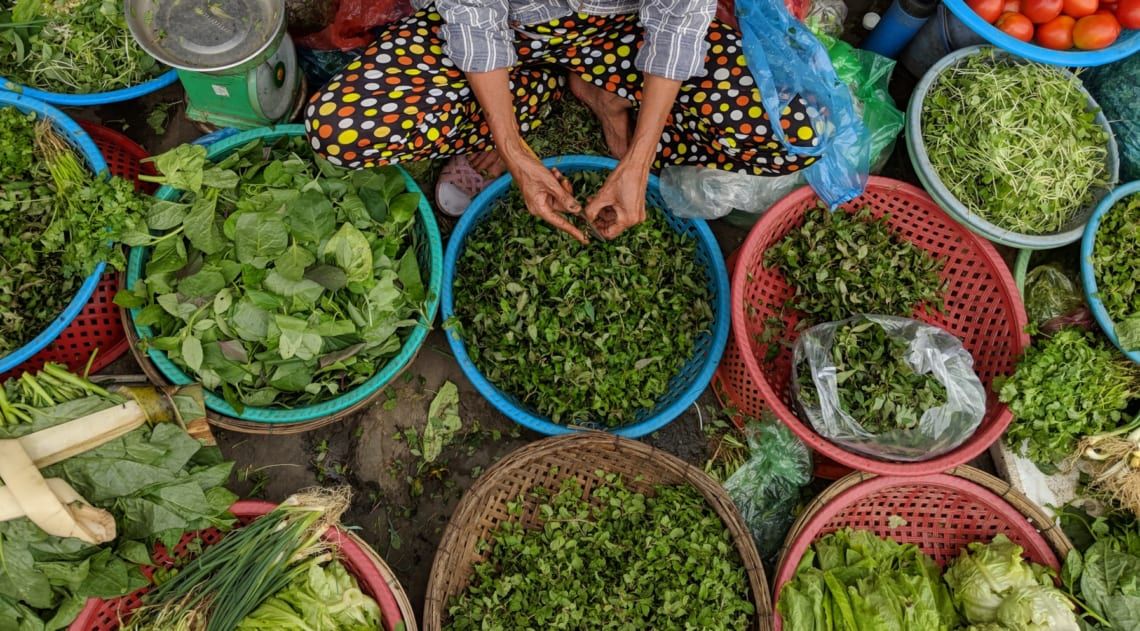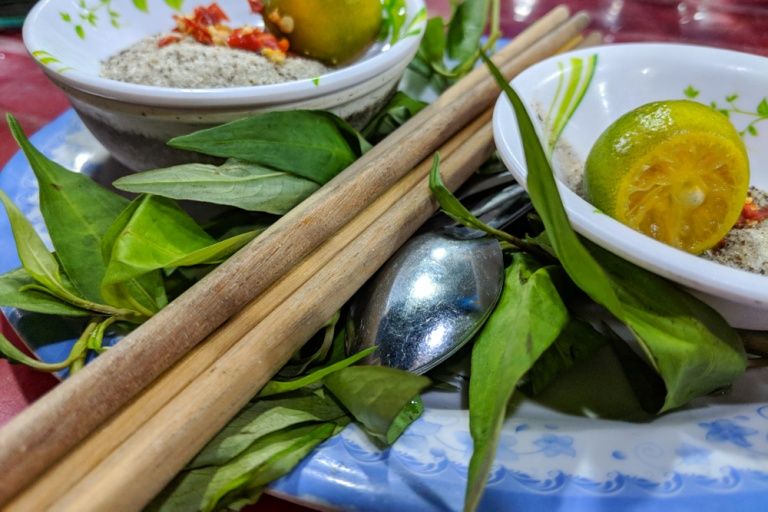
Vietnamese herbs in the food
Table of contents
Vietnamese cuisine rhymes simplicity and refinement of flavors, a gourmet feat obtained – to be other – by the use of aromatic herbs (rau thom , in the language of Uncle Ho). These are added at the time of cooking or presented on the table in order to add additional flavors, or even to sublimate those already present. Let’s do some introductions about the main Vietnamese herbs…
List of the main Vietnamese herbs:
Dill – Rau thi la
Only herb that is cooked unlike others in Vietnamese cuisine. She performs with immense happiness in the famous Cha Ca La Vong , one of the signature dishes of the capital. It is a grilled fish, fried with dill and served with bun (rice vermicelli) and aromatic herbs (among others). There is also a recipe for fish balls with dill and Chinese chives… I’m just telling you that!
Thai Basil – Hung Que or Rau Que
Un basic. Thai basil (sometimes referred to as Asian basil) offers a bouquet with flavors of anise, cinnamon and cloves. Some find a very spicy base, close to tarragon or anise. It pairs perfectly with soups, noodle dishes and grilled meats. A bowl of hu tieu would feel sorely lonely without hung que.
Betel – La Lot
 With its heart-shaped leaves from the pepper family, it requires heating so that it can release its aromatic flavors. It is chopped to be incorporated into the soup or used to tenderly wrap the meat before grilling it (We can never praise enough the delicacy of a bo la lot!).
With its heart-shaped leaves from the pepper family, it requires heating so that it can release its aromatic flavors. It is chopped to be incorporated into the soup or used to tenderly wrap the meat before grilling it (We can never praise enough the delicacy of a bo la lot!).
Chinese chives – Hoa He
Its taste reminds us of garlic. By the way, if you don’t have any on hand in your kitchen, you can use shallots instead . It is not the most common, but its flowers can also be used. In Vietnamese cuisine, Hoa Hue leaves garnish spring rolls, salads or accompany typical noodle soups (hu tieu Nam Vang, to speak only of him). Very close, the spring onion (Hanh Hoa) seasons just about any dish, including stir-fries, with application.
Lemongrass – Xa, sometimes spelled Sa
Shrimps, chicken, salmon… there are many dishes that give it pride of place. It is also used in infusion or in cocktails. Also, it can be added to mint tea, and it goes very well with coconut, chilli, ginger and garlic. It will also titillate soup, stew, and other curries . More surprisingly, it also serves as a skewer for shrimp or beef skewers (especially in Hue cuisine).
Coriander(s) – Mui in the North, Ngo in the South
It has the reputation of being the most widely used herb in the world. It adds a pop of green color and a distinctive flavor to a host of Vietnamese dishes. The whole plant is used in cooking – leaves and stems (in chicken coleslaw) and even the roots, in chicken broth. It goes very well with lemongrass in curry or in a tamarind seafood fondue. Ngo om leaves are used for pickles, soups such as sweet and sour soup ( canh chua ) or pho . The variant called sawtooth coriander ( mui tau) goes wonderfully in soups (don’t even imagine a pho without mui tau!), chicken rice soup, bamboo shoots and stews.
Several herbs claim to be cilantro with remarkably random scientific precision and rough translations.
Spiky Coriander – Ngo Gai
Known as Culantro , Ngò gai is used especially in soups (especially pho ), and also in many salads. A few leaves of ngò gai, chopped and sprinkled over the Vietnamese sausage fried rice (lap xuong ) will give it an exquisite taste.
Vietnamese coriander – Rau Ram
 A unique plant in Southeast Asia, rau ram is also known as pungent mint or false mint or even Vietnamese mint or even (let’s not be afraid) Chinese basil. You may know her by the Malaysian name of Laksa . Either way, you’ll recognize it by the V-shaped dark purple spot on its leaves. It is used as a garnish mixed with other herbs to accompany certain dishes. Rau ram leaves, slightly spicy and lemony, flavor meats, salads and soups. Rau Ram is the essential companion for hatched eggs. And monks and other monks because of its anaphrodisiac properties.
A unique plant in Southeast Asia, rau ram is also known as pungent mint or false mint or even Vietnamese mint or even (let’s not be afraid) Chinese basil. You may know her by the Malaysian name of Laksa . Either way, you’ll recognize it by the V-shaped dark purple spot on its leaves. It is used as a garnish mixed with other herbs to accompany certain dishes. Rau ram leaves, slightly spicy and lemony, flavor meats, salads and soups. Rau Ram is the essential companion for hatched eggs. And monks and other monks because of its anaphrodisiac properties.
Bonus: some people think cilantro tastes like soap or dirty feet. So if you’re wondering how to say “No coriander” in Vietnamese, just say ” không rau mui » if you are in the North of Vietnam and « không rau ngo if you are in southern Vietnam.
Mint – Rau Hung Lui ou Hung Kay
Very aromatic, spicier and sweeter than spearmint, it will energize soups, spring rolls ( goi cuon ) and grilled meats. You will also find it in Vietnamese pancakes ( banh xeo ) but also in certain drinks ( starting with tea ) and fruit cocktails.
Chinese pepper (or pepper grass ) – Rau Diep Ca
In English it gives: Fish Mint, and quite frankly, this plant stinks of feet. Let’s say that its very pronounced smell captivates some and repel others. Defiantly accompanies grilled meats and fish dishes.
Périlla red / Shiso – Rau Tia To
In Japan, this plant is called shiso and in China, zi su. Its flavor is reminiscent of lemon mint or cumin. In fact, its taste is very particular and unlike any other. In other words, when shiso is essential in a recipe, there is p rilla in the kitchen to replace it.
Its leaves are green on one side and purple on the other. The red perilla goes well with dishes that have a lot of character such as pancakes banh xeo and bun cha . Tía to can be found in typical Vietnamese dishes such as rice porridge (chao) and vermicelli soup with winkles (bun oc). They are also intended to flavor salads ( gỏi ) and spring rolls ( goi cun ). It is quite possible to prepare perilla as it is, like a vegetable, which gives a beet-red broth that some people like.
There is a green version ( rau kinh gioi ), with a very strong flavor of lemongrass. Once chopped, it flavors soups, salads and certain noodle dishes.
Photos of main Vietnamese herbs:








More information about Vietnamese herbs here >



